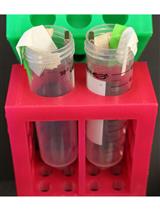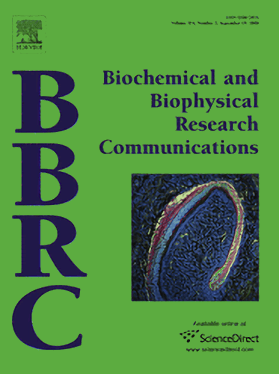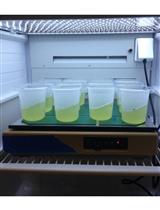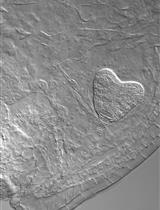- EN - English
- CN - 中文
Extraction of RNA from Recalcitrant Tree Species Paulownia elongata
从顽拗型树种泡桐中提取RNA
发布: 2018年07月20日第8卷第14期 DOI: 10.21769/BioProtoc.2925 浏览次数: 7605
评审: Samik BhattacharyaLaia ArmengotAnonymous reviewer(s)

相关实验方案

从标记的细胞类型中分离细胞核、提取RNA并去除核糖体RNA以用于RNA-Seq 分析
Mauricio A. Reynoso [...] Kaisa Kajala
2018年04月05日 16071 阅读
Abstract
Isolation of pure RNA is the basic requisite for most molecular biology work. Plants contain polyphenols and polysaccharides, which can interfere with isolation of pure RNA from them. Especially hardwood tree species like Paulownia elongata have surplus amount of RNA-binding alkaloids, proteins and secondary metabolites that can further complicate the process of RNA extraction. Paulownia elongata is a fast-growing tree species which is known for its role in environmental adaptability and biofuel research. Here we describe an economical, efficient and time-saving method (2 h) to extract RNA from leaf tissues of the tree Paulownia elongata. Lack of DNA contamination and good RNA integrity were confirmed using RNA Gel electrophoresis. The purity of RNA was confirmed using Nanodrop spectrophotometer that revealed an A260:A280 ratio of about 2.0. The purified RNA was successfully used in the downstream applications such as RT-PCR (Reverse Transcription PCR) and qPCR (quantitative PCR). This method could be used for RNA extraction from several other recalcitrant tree species.
Keywords: RNA (核糖核酸)Background
Paulownia elongata is a widely distributed tree that belongs to the family of Paulowniaceae (Zhu et al., 1986). It is known for its high adaptability and rapid growth rate (Chaires et al., 2017). Paulownia woods are gaining demands from all over the world due to their high stability, low thermal conductivity, decay and rot resistance etc. (Ayrilmis and Kaymakci, 2013). Apart from this, P. elongata is also known to show tolerance to a variety of biotic and abiotic stresses (Chaires et al., 2017). However not many studies are done on understanding its stress tolerance mechanism, which requires extraction of high-quality RNA.
High-quality RNA refers to RNA that is devoid of any genomic DNA, phenols, polysaccharides, secondary metabolites, etc. that interfere with molecular biology techniques (Ouyang et al., 2014). Genomic DNA contamination will affect the detection and quantification of gene expression analysis such as RT-PCR, qPCR, northern blotting and RNA sequencing (Añez-Lingerfelt et al., 2009). This is because the reaction cannot differentiate between cDNA (complementary DNA) and genomic DNA, which will lead to overestimation of gene expression present (Añez-Lingerfelt et al., 2009). Phenols in RNA can oxidize to form quinones that will bind to nucleic acids irreversibly (Ouyang et al., 2014). Polysaccharides and secondary metabolites can co-precipitate and degrade the RNA in the sample thereby affecting the yield, quality and downstream applications of RNA (Ouyang et al., 2014; Ghawana et al., 2011). Since P. elongata leaves are known to have a high content of alkaloids and proteins (Kirov et al., 2014), isolation of pure RNA from them poses a challenge. Methods using spin columns did not yield a good amount of RNA (data not shown) from P. elongata leaves, and this could be due to the fact that spin columns efficiency decreases in the presence of alkaloids (Ouyang et al., 2014). CTAB (cetyltrimethyl ammonium bromide) based methods are spin-column free but are time-consuming (Ouyang et al., 2014). Thus, we combined the Trizol (InvitrogenTM) extraction method and spin-column based purification method in our protocol.
In our study we extracted high quantity RNA using a modified Trizol (InvitrogenTM) method. The quality of RNA was improved by using RNA Clean and Concentrator Kit (ZYMO RESEARCH, USA) with modifications. The RNA yield was measured using Nanodrop spectrophotometer (Figure 1). The Nanodrop measurement peaks can also analyze the presence of phenols or polysaccharides in the sample. In our study, the peak indicated that the RNA was free from phenol or polysaccharide contamination (Figure 1). The integrity of the RNA was further affirmed by running an RNA gel (Formaldehyde free RNA gel kit, Amresco, USA). The gel revealed that the RNA extracted using our method was free from genomic DNA contamination. Clear 28S and 18S rRNA bands were observed (Figure 2). The RNA was then successfully used in downstream applications like RT-PCR and qPCR which amplified the ubiquitin gene (Figures 3 and 4). In RT-PCR, we used cDNA synthesized from our P. elongata RNA as the template. The cDNA was amplified using ubiquitin qPCR primers. The ubiquitin primers used in the study are as follows:
Forward Primer- 5’ GTC AGG AGG AAC ACC TTC TTT 3’
Reverse Primer- 5’ CCT TGA CTG GGA AGA CCA TTAC 3’
Thus bands of about 250 bp were observed as a result of successful amplification of ubiquitin (Figure 3). Our method of RNA isolation not only has high and pure yield but is also time-saving. The entire procedure takes about 2 h.
Materials and Reagents
- Nuclease-free microfuge tubes
- Nuclease-free micropipette tips
- Nitrile powder free gloves
- Liquid nitrogen
- RNase (ribonuclease) Away (Thermo Fisher Scientific, catalog number: 7000TS1 )
- Trizol (Thermo Fisher Scientific, InvitrogenTM, catalog number: 15596026 )
- 24:1 Chloroform:Isoamyl alcohol (Acros Organics, catalog number: 327155000 )
- 75% and 100% ethanol
- Nuclease-free water (Not DEPC-treated) (Thermo Fisher Scientific, InvitrogenTM, catalog number: 4387936 )
- Turbo DNase (deoxyribonuclease) (Thermo Fisher Scientific, AmbionTM, catalog number: AM2238 )
- RNA Clean and Concentrator kit (ZYMO RESEARCH, catalog number: R1015 )
- Chilled isopropanol
Equipment
- Pipettes (BioExpress, GeneMate, catalog number: P-3960-20 )
- Mortar and pestle (Harold Import, HIC, catalog number: 43717 )
- Vortexer (BioExpress, GeneMate, catalog number: S-3200-1 )
- Refrigerated microcentrifuge (Labnet International, catalog number: C2500-R )
- Water bath
- -80 °C freezer
- Fume hood (KEWAUNEE, model: H05_5460-00 )
- Nanodrop Spectrophotometer (Thermo Fisher Scientific, USA)
Procedure
文章信息
版权信息
© 2018 The Authors; exclusive licensee Bio-protocol LLC.
如何引用
Ramadoss, N. and Basu, C. (2018). Extraction of RNA from Recalcitrant Tree Species Paulownia elongata. Bio-protocol 8(14): e2925. DOI: 10.21769/BioProtoc.2925.
分类
植物科学 > 植物分子生物学 > RNA > RNA 提取
分子生物学 > RNA > RNA 提取
您对这篇实验方法有问题吗?
在此处发布您的问题,我们将邀请本文作者来回答。同时,我们会将您的问题发布到Bio-protocol Exchange,以便寻求社区成员的帮助。
Share
Bluesky
X
Copy link












